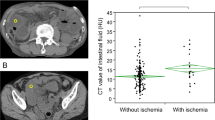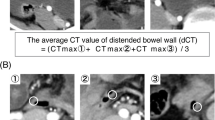Abstract
Background
Proper management of small bowel obstruction (SBO) requires a methodology to prevent nontherapeutic laparotomy while minimizing the chance of overlooking strangulation obstruction causing intestinal ischemia. Our aim was to identify preoperative risk factors associated with strangulating SBO and to develop a model to predict the need for operative intervention in the presence of an SBO. Our hypothesis was that free intraperitoneal fluid on computed tomography (CT) is associated with the presence of bowel ischemia and need for exploration.
Methods
We reviewed 100 consecutive patients with SBO, all of whom had undergone CT that was reviewed by a radiologist blinded to outcome. The need for operative management was confirmed retrospectively by four surgeons based on operative findings and the patient’s clinical course.
Results
Patients were divided into two groups: group 1, who required operative management on retrospective review, and group 2 who did not. Four patients who were treated nonoperatively had ischemia or died of malignant SBO and were then included in group 1; two patients who had a nontherapeutic exploration were included in group 2. On univariate analysis, the need for exploration (n = 48) was associated (p < 0.05) with a history of malignancy (29% vs. 12%), vomiting (85% vs. 63%), and CT findings of either free intraperitoneal fluid (67% vs. 31%), mesenteric edema (67% vs. 37%), mesenteric vascular engorgement (85% vs. 67%), small bowel wall thickening (44% vs. 25%) or absence of the “small bowel feces sign” (so-called fecalization) (10% vs. 29%). Ischemia (n = 11) was associated (p < 0.05 each) with peritonitis (36% vs. 1%), free intraperitoneal fluid (82% vs. 44%), serum lactate concentration (2.7 ± 1.6 vs. 1.3 ± 0.6 mmol/l), mesenteric edema (91% vs. 46%), closed loop obstruction (27% vs. 2%), pneumatosis intestinalis (18% vs. 0%), and portal venous gas (18% vs. 0%). On multivariate analysis, free intraperitoneal fluid [odds ratio (OR) 3.80, 95% confidence interval (CI) 1.5–9.9], mesenteric edema (OR 3.59, 95% CI 1.3–9.6), lack of the “small bowel feces sign” (OR 0.19, 95% CI 0.05–0.68), and a history of vomiting (OR 4.67, 95% CI 1.5–14.4) were independent predictors of the need for operative exploration (p < 0.05 each). The combination of vomiting, no “small bowel feces sign,” free intraperitoneal fluid, and mesenteric edema had a sensitivity of 96%, and a positive predictive value of 90% (OR 16.4, 95% CI 3.6–75.4) for requiring exploration.
Conclusion
Clinical, laboratory, and radiographic factors should all be considered when making a decision about treatment of SBO. The four clinical features—intraperitoneal free fluid, mesenteric edema, lack of the “small bowel feces sign,” history of vomiting—are predictive of requiring operative intervention during the patient’s hospital stay and should be factored strongly into the decision-making algorithm for operative versus nonoperative treatment.



Similar content being viewed by others

References
Mucha P (1987) Small intestinal obstruction. Surg Clin North Am 67:597–620
Bizer LS, Liebling RW, Delany HM et al (1981) Small bowel obstruction. Surgery 89:407–413
Silen W, Hein MF, Goldman L (1962) Strangulation obstruction of the small intestine. Arch Surg 85:137–145
Laws HL, Aldrete JS (1976) Small bowel obstruction: a review of 465 cases. South Med J 69:733–734
Bickell NA, Federman AD, Aufses AH (2005) Influence of time on risk of bowel resection in complete small bowel obstruction. J Am Coll Surg 201:847–854
Fevang BT, Jensen D, Svanes K et al (2002) Early operation or conservative management of patients with small bowel obstruction? Eur J Surg 168:475–481
Shrock TR (1988) Small intestine. In: Way LW (ed) Current surgical diagnosis and treatment. Appleton & Lange, Norwalk, CT, pp 561–585
Barnett WO, Petro AB, Williamson JW (1976) A current appraisal of problems with gangrenous bowel. Ann Surg 183:653–659
Sheedy SP, Earnest F IV, Fletcher JG et al (2006) CT of small-bowel ischemia associated with obstruction in emergency department patients: diagnostic performance evaluation. Radiology 241:729–736
Catalano O (1997) The faeces sign: a CT finding in small-bowel obstruction. Radiologe 37:417–419
Mayo-Smith WW, Wittenberg J, Bennett GL et al (1995) The CT small bowel faeces sign: description and clinical significance. Clin Radiol 50:765–767
Sarr MG, Bulkley GB, Zuidema GD (1983) Preoperative recognition of intestinal strangulation. Am J Surg 145:176–182
Balthazar EJ, Birnbaum BA, Megibow AJ et al (1992) Closed-loop and strangulating intestinal obstruction: CT signs. Radiology 185:769–775
Maglinte DD, Gage SN, Harmon BH et al (1993) Obstruction of the small intestine: accuracy and role of CT in diagnosis. Radiology 188:61–64
Frager D, Medwid SW, Baer JW et al (1994) CT of small-bowel obstruction: value in establishing the diagnosis and determining the degree and cause. AJR Am J Roentgenol 162:37–41
Maglinte DDT, Howard TJ, Lillemoe KD et al (2008) Small-bowel obstruction: state-of-the-art imaging and its role in clinical management. Clin Gastroenterol Hepatol 6:130–139
Chou CK, Mak CW, Tzeng WS et al (2004) CT of small bowel ischemia. Abdom Imaging 29:18–22
Argov S, Itzkovitz D, Wiener F (1989) A new method for differentiating simple intra-abdominal from strangulated small-intestinal obstruction. Curr Surg 46:456–460
O’Daly BJ, Ridgway PF, Keenan N et al (2009) Detected peritoneal fluid in small bowel obstruction is associated with the need for surgical intervention. Can J Surg 52:201–206
Ha HK, Kim JS, Lee MS et al (1997) Differentiation of simple and strangulated small-bowel obstructions: usefulness of known CT criteria. Radiology 204:507–512
Assalia A, Schein M, Kopelman D et al (1994) Therapeutic effect of oral Gastrografin in adhesive, partial small-bowel obstruction: a prospective randomized trial. Surgery 115:433–437
Biondo S, Pares D, Mora L et al (2003) Randomized clinical study of Gastrografin® administration in patients with adhesive small bowel obstruction. Br J Surg 90:542–546
Zhang Y, Gao Y, Ma Q et al (2006) Randomised clinical trial investigating the effects of combined administration of octreotide and methylglucamine diatrizoate in the older persons with adhesive small bowel obstruction. Dig Liver Dis 38:188–194
Chen SC, Chang KJ, Lee PH et al (1999) Oral urograffin in postoperative small bowel obstruction. World J Surg 23:1051–1054
Chen SC, Lin FY, Lee PH et al (1998) Water-soluble contrast study predicts the need for early surgery in adhesive small bowel obstruction. Br J Surg 85:1692–1694
Feigin E, Seror D, Szold A et al (1996) Water-soluble contrast material has no therapeutic effect on postoperative small bowel obstruction: results of a prospective randomized clinical trial. Am J Surg 171:227–229
Kumar P, Kaman L, Singh G et al (2009) Therapeutic role of oral water soluble iodinated contrast agent in postoperative small bowel obstruction. Singap Med J 50:360–364
Fevang BT, Jensen D, Fevang J et al (2000) Upper gastrointestinal contrast study in the management of small bowel obstruction: a prospective randomised study. Eur J Surg 166:39–43
Maglinte DDT, Balthazar EJ, Kelvin FM et al (1997) The role of radiology in the diagnosis of small bowel obstruction. AJR Am J Roentgenol 168:1171–1180
Makita O, Ikushima I, Matsumoto N et al (1999) CT differentiation between necrotic and nonnecrotic small bowel in closed loop and strangulating obstruction. Abdom Imaging 24:120–124
Jones K, Mangram AJ, Lebron RA et al (2007) Can a computed tomography scoring system predict the need for surgery in small-bowel obstruction? Am J Surg 194:780–784
Rocha FG, Theman TA, Matros E et al (2009) Nonoperative management of patients with a diagnosis of high-grade small bowel obstruction by computed tomography. Arch Surg 144:1000–1005
Author information
Authors and Affiliations
Corresponding author
Rights and permissions
About this article
Cite this article
Zielinski, M.D., Eiken, P.W., Bannon, M.P. et al. Small Bowel Obstruction—Who Needs an Operation? A Multivariate Prediction Model. World J Surg 34, 910–919 (2010). https://doi.org/10.1007/s00268-010-0479-3
Published:
Issue Date:
DOI: https://doi.org/10.1007/s00268-010-0479-3



